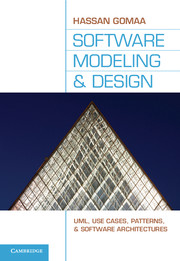Book contents
- Frontmatter
- Contents
- Preface
- Annotated Table of Contents
- Acknowledgments
- PART I Overview
- 1 Introduction
- 2 Overview of the UML Notation
- 3 Software Life Cycle Models and Processes
- 4 Software Design and Architecture Concepts
- 5 Overview of Software Modeling and Design Method
- PART II Software Modeling
- PART III Architectural Design
- PART IV Case Studies
- Appendix A Catalog of Software Architectural Patterns
- Appendix B Teaching Considerations
- Glossary
- Answers to Exercises
- Bibliography
- Index
2 - Overview of the UML Notation
from PART I - Overview
Published online by Cambridge University Press: 05 June 2012
- Frontmatter
- Contents
- Preface
- Annotated Table of Contents
- Acknowledgments
- PART I Overview
- 1 Introduction
- 2 Overview of the UML Notation
- 3 Software Life Cycle Models and Processes
- 4 Software Design and Architecture Concepts
- 5 Overview of Software Modeling and Design Method
- PART II Software Modeling
- PART III Architectural Design
- PART IV Case Studies
- Appendix A Catalog of Software Architectural Patterns
- Appendix B Teaching Considerations
- Glossary
- Answers to Exercises
- Bibliography
- Index
Summary
The notation used for the COMET method is the Unified Modeling Language (UML). This chapter provides a brief overview of the UML notation. The UML notation has evolved since it was first adopted as a standard in 1997. A major revision to the standard was made in 2003, so the current version of the standard is UML 2. The previous versions of the standard are referred to as UML 1.x.
The UML notation has grown substantially over the years, and it supports many diagrams. The approach taken in this book is the same as Fowler's (2004), which is to use only those parts of the UML notation that provide a distinct benefit. This chapter describes the main features of the UML notation that are particularly suited to the COMET method. The purpose of this chapter is not to be a full exposition of UML, because several detailed books exist on this topic, but rather to provide a brief overview. The main features of each of the UML diagrams used in this book are briefly described, but lesser-used features are omitted. The differences between UML 2 notation and UML 1.x notation are also briefly explained.
UML DIAGRAMS
The UML notation supports the following diagrams for application development:
Use case diagram, briefly described in Section 2.2.
Class diagram, briefly described in Section 2.4.
Object diagram (an instance version of the class diagram), which is not used by COMET.
Communication diagram, which in UML 1.x was called the collaboration diagram, briefly described in Section 2.5.1.
[…]
- Type
- Chapter
- Information
- Software Modeling and DesignUML, Use Cases, Patterns, and Software Architectures, pp. 14 - 28Publisher: Cambridge University PressPrint publication year: 2011



